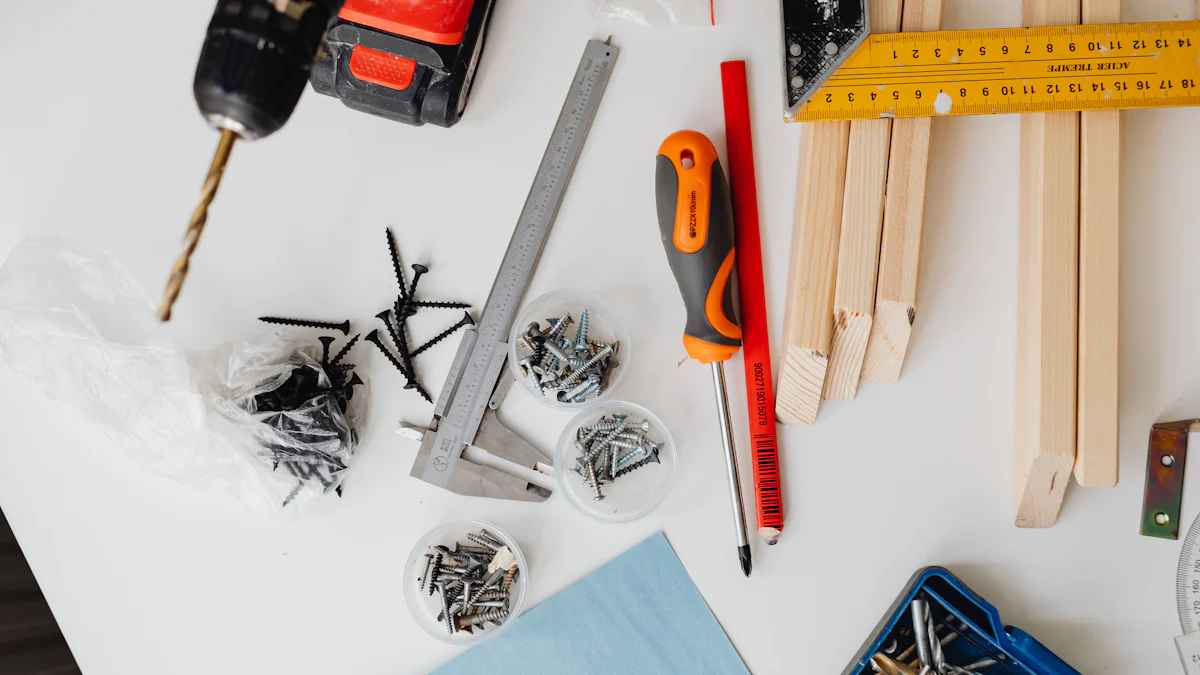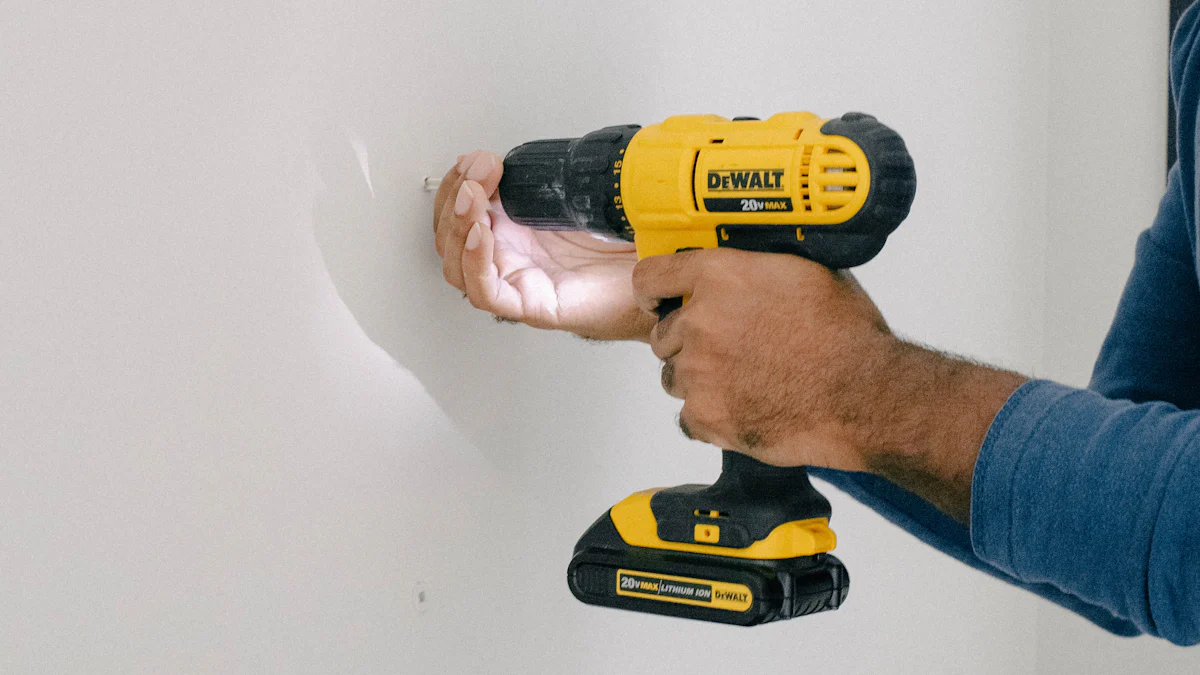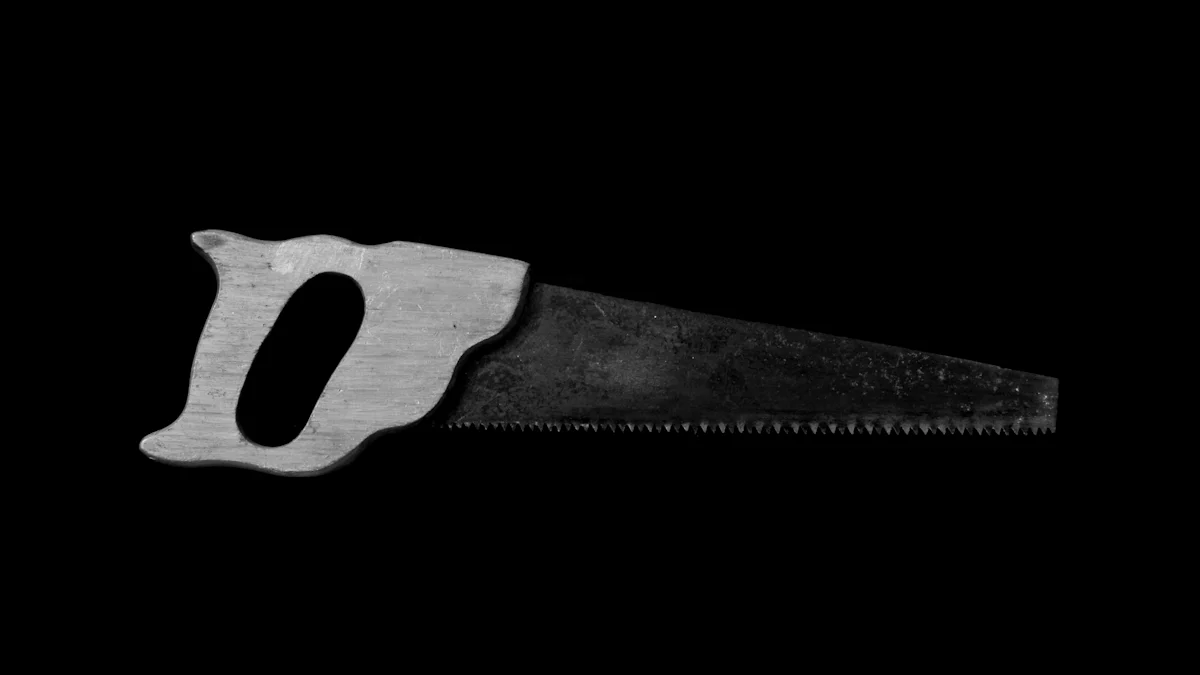
Tackling home projects can feel like a daunting task without the right hardware tool. Imagine trying to hang a picture or fix a leaky faucet without the proper equipment. The right tools make every job easier and more efficient. Did you know that 45% of DIY enthusiasts use digital tools to plan their projects? This shows how essential good tools are. In this guide, you’ll discover ten must-have tools that will transform your home improvement experience. Get ready to dive into a world where every project feels achievable and fun.
Hammer
Description
Types of hammers
Hammers come in various types, each designed for specific tasks. The claw hammer is a common choice for driving nails and removing them with ease. A ball peen hammer is perfect for metalwork tasks. The flat striking surface on one side and a rounded one on the other make it versatile. For those delicate tasks, a rubber mallet provides a gentle touch. The large rubber head prevents damage when striking surfaces. A brick hammer is ideal for breaking bricks or stones. The flat face and chisel-like blade make it a favorite among stonemasons.
Common uses
Hammers serve many purposes in home projects. You can use a claw hammer to hang pictures or assemble furniture. A ball peen hammer works well for shaping metal and setting rivets. Rubber mallets are handy for installing flooring or setting stepping stones. Brick hammers help break off pieces of brick or concrete. Each type of hammer offers unique benefits for different tasks.
Features
Material and design
The design and material of a hammer impact its performance. Most hammers have steel heads for durability. A ball peen hammer often features a hardened steel head. This reduces the risk of chipping during metalwork. Handles vary in material, with hickory being a popular choice for its strength. Fiberglass handles provide a lightweight and shock-absorbing alternative.
Ergonomics
Ergonomics play a crucial role in a hammer’s usability. A comfortable grip reduces hand fatigue during extended use. Many hammers feature rubberized grips for better control. The weight distribution also affects how easily you can swing the tool. A well-balanced hammer makes tasks more efficient and less tiring.
Screwdriver Set
Description
Types of screwdrivers
A screwdriver set is a fundamental hardware tool in every home. You will find different types of screwdrivers for various tasks. A Phillips screwdriver is popular for its cross-shaped tip, which provides a strong grip on screws. A flat head screwdriver has a straight edge, making it suitable for slotted screws. Some sets include a combination screwdriver that offers both Phillips and flat head options. This versatility ensures you have the right tool for any job.
Versatility in use
Screwdriver sets offer incredible versatility. You can use them for assembling furniture, fixing appliances, or even opening battery compartments. A good set will cover all your basic needs. Many sets come with additional features like a nut driver, adding to their functionality. This makes a screwdriver set an essential hardware tool for any homeowner.
Features
Magnetic tips
Magnetic tips are a game-changer in screwdrivers. They hold screws securely, preventing them from falling during use. This feature is especially helpful when working in tight spaces. Magnetic tips save time and reduce frustration by keeping screws in place. You will appreciate this feature when tackling tricky tasks.
Handle grip
A comfortable handle grip is crucial in a screwdriver set. Ergonomic designs reduce hand fatigue and improve control. Rubberized grips provide a non-slip surface, ensuring precision in every turn. A well-designed handle enhances the overall experience of using this hardware tool. You will notice the difference in comfort and efficiency.
Tape Measure
Description
Importance in measurements
A tape measure stands as a vital hardware tool for any home project. Accurate measurements ensure that everything fits perfectly. Imagine trying to fit a new couch into your living room without knowing the dimensions. A tape measure helps you avoid such mishaps. This tool provides precision, whether you’re hanging curtains or building a bookshelf. Every DIY enthusiast knows the value of getting measurements right the first time.
Different lengths available
Tape measures come in various lengths to suit different tasks. A standard 12-foot tape is perfect for smaller interior projects. This size fits easily in a tool belt and handles most household needs. For larger projects, a 25-foot tape measure, often called a builder’s tape, works wonders. This tool measures room dimensions or wall distances with ease. Outdoor projects may require a 100-foot cloth tape. This longer tape handles property boundaries or landscaping tasks efficiently. Each length serves a specific purpose, making the tape measure a versatile hardware tool.
Features
Locking mechanism
The locking mechanism on a tape measure enhances its usability. This feature holds the tape in place while you take measurements. No more struggling to keep the tape from retracting. The locking mechanism ensures accuracy by keeping the tape steady. This simple yet effective feature makes measuring tasks much easier.
Durability
Durability is a key factor in choosing a tape measure. A robust design withstands wear and tear from frequent use. Look for a tape measure with a sturdy case and a strong blade. These elements ensure the tool lasts through many projects. A durable tape measure proves to be a reliable hardware tool in your collection.
Level
Description
Purpose of a level
A level is an essential hardware tool for ensuring surfaces are perfectly horizontal or vertical. Imagine hanging a shelf and realizing it’s crooked. A level prevents such mishaps by helping you achieve precision. This tool is vital for tasks like installing cabinets, aligning pictures, or laying tiles. Every DIY enthusiast needs a reliable level to ensure projects look professional.
Types of levels
You will find several types of levels available, each suited for different tasks. The bubble level is a classic choice with its simple design. It uses a liquid-filled vial to indicate levelness. A laser level projects a straight line across surfaces, making it ideal for larger projects. This type offers precision and ease of use. The digital level provides a digital readout for exact measurements. This advanced tool suits those who require high accuracy. Each type of level serves specific purposes, making them indispensable hardware tools.
Features
Accuracy
Accuracy is the most crucial feature of a level. You need a tool that delivers precise results every time. Bubble levels rely on the position of the bubble within the vial. Laser levels use advanced technology to project straight lines. Digital levels offer numerical readings for exact angles. Choose a level that meets your accuracy needs for successful home projects.
Build quality
The build quality of a level determines its durability and reliability. A well-constructed level withstands frequent use without losing accuracy. Look for levels made from sturdy materials like aluminum or high-grade plastic. These materials ensure the tool remains in good condition over time. A robust level proves to be a valuable hardware tool in your collection.
Power Drill

Description
Corded vs. cordless
A power drill stands as a vital hardware tool in any home project toolkit. You might wonder whether to choose a corded or cordless model. Corded drills offer consistent power and never run out of juice. These models work well for long projects where you need uninterrupted performance. Cordless drills, on the other hand, provide freedom of movement. You can take them anywhere without worrying about finding an outlet. Modern cordless drills come with lithium-ion batteries. These batteries offer longer life and quick recharging times. The choice between corded and cordless depends on your specific needs.
Applications
Power drills serve multiple purposes in home improvement tasks. You can use them to drill holes in wood, metal, or plastic. They also work well for driving screws into various materials. A cordless drill becomes indispensable when hanging shelves or assembling furniture. Some people even use these versatile tools for building decks. With the right attachments, a power drill handles a wide range of tasks efficiently. This hardware tool proves its worth in every project.
Features
Battery life
Battery life plays a crucial role in the performance of a cordless power drill. Lithium-ion batteries provide consistent power output. These batteries last longer and recharge quickly. You won’t face frequent interruptions during your projects. A good battery ensures that your hardware tool remains ready for action. Always check the battery specifications before purchasing a cordless drill.
Speed settings
Speed settings enhance the versatility of a power drill. Adjustable speed allows you to control the drilling or driving force. Lower speeds work well for delicate tasks. Higher speeds suit heavy-duty applications. A drill with multiple speed settings adapts to different materials and tasks. This feature makes the hardware tool more efficient and user-friendly.
Pliers
Description
Types of pliers
Pliers come in various types, each serving unique purposes. Long nose pliers, also known as needle-nose pliers, feature slim, tapered jaws. These jaws make them perfect for reaching into tight spaces and gripping small objects. Slip-joint pliers offer adjustable jaws, allowing you to handle different sizes of objects. Diagonal pliers excel at cutting wires and small pins. Locking pliers provide a firm grip on objects, making them ideal for holding items securely. Each type of plier offers specific benefits for different tasks.
Common tasks
Pliers prove invaluable for many home projects. Use long nose pliers for intricate work like electronics or jewelry-making. Slip-joint pliers help with general gripping and twisting tasks. Diagonal pliers cut wires cleanly and efficiently. Locking pliers hold objects firmly in place, freeing your hands for other tasks. Pliers serve as versatile tools for various household needs.
Features
Jaw design
The jaw design of pliers determines their functionality. Long nose pliers have pointed jaws for precision work. Slip-joint pliers feature adjustable jaws for versatility. Diagonal pliers have sharp edges for cutting tasks. Locking pliers boast strong jaws for a secure grip. Each jaw design caters to specific tasks, enhancing the tool’s effectiveness.
Handle comfort
Handle comfort plays a crucial role in the usability of pliers. Ergonomic handles reduce hand fatigue during prolonged use. Many pliers feature rubberized grips for better control. A comfortable handle ensures precision and ease of use. You will appreciate this feature when working on detailed projects.
Utility Knife
Description
Uses in home projects
A utility knife proves invaluable for various home projects. You can use it to cut through materials like cardboard, plastic, and drywall. A utility knife handles tasks that require precision and speed. Imagine needing to trim wallpaper or open a stubborn package. A utility knife makes these tasks simple and efficient. The tool’s versatility makes it a staple in any DIY toolkit.
Safety features
Safety features enhance the utility knife’s usability. Many models come with retractable blades. This feature allows you to store the knife safely when not in use. A retractable blade reduces the risk of accidental cuts. Always remember to cut away from yourself for added safety. A utility knife with safety features ensures a secure and effective cutting experience.
Features
Blade material
The blade material determines the utility knife’s performance. High-quality steel blades offer sharpness and durability. A sharp blade ensures clean cuts through various materials. Steel blades resist rust and maintain their edge longer. Choosing a utility knife with a durable blade enhances its effectiveness in home projects.
Retractable design
A retractable design adds convenience to a utility knife. You can easily extend the blade for use and retract it for storage. This feature protects the blade and prevents accidental injuries. A retractable design also keeps the blade sharp by minimizing exposure. A utility knife with this design provides both safety and functionality.
Adjustable Wrench
Description
Versatility
An adjustable wrench is a must-have tool for any homeowner. You can use it to tighten or loosen nuts and bolts. The adjustable jaw fits various sizes of fasteners. This makes the wrench incredibly versatile. You can tackle different tasks without needing multiple tools. Whether you’re working on plumbing or assembling furniture, an adjustable wrench will come in handy.
Size range
Adjustable wrenches come in different sizes. A six-inch wrench provides enough torque for big jobs. It remains manageable for smaller tasks. Larger wrenches offer more leverage. These are great for tougher tightening or loosening jobs. You can choose a size that fits your specific needs. A longer handle can help with stubborn fasteners. The right size wrench makes your work easier and more efficient.
Features
Jaw capacity
The jaw capacity of an adjustable wrench determines its usefulness. A wider jaw can accommodate larger fasteners. You can adjust the width by spinning the knurl. This feature allows you to grip a variety of nut and bolt sizes. A good jaw capacity ensures that the wrench can handle most household tasks. You won’t need to switch tools frequently.
Material strength
Material strength plays a crucial role in a wrench’s performance. High-quality materials ensure durability and reliability. A strong wrench withstands the pressure of tough jobs. You can rely on it for years without worrying about wear and tear. Look for wrenches made from robust materials. This choice will provide long-lasting service in your toolkit.
Saw

Description
Types of saws
Saws come in many types, each serving a unique purpose. A circular saw is perfect for cutting straight lines and slicing through plywood. This tool trims 2x4s quickly and efficiently. A jigsaw excels at making curved cuts and intricate designs. The reciprocating saw handles demolition tasks with ease. You can cut through wood, metal, and plastic with this powerful tool. A miter saw helps you make precise angle cuts, ideal for molding and trim work. Each saw type offers specific benefits for different projects.
Cutting capabilities
The cutting capabilities of saws vary based on their design. A circular saw provides fast and accurate cuts for large sheets of material. Jigsaws offer flexibility for detailed work and curved cuts. Reciprocating saws excel in rough cuts and demolition tasks. Miter saws deliver precision in angled cuts, perfect for framing and carpentry. Each saw type enhances your ability to complete diverse home projects.
Features
Blade quality
Blade quality plays a crucial role in a saw’s performance. High-quality blades ensure clean and precise cuts. Circular saws often feature carbide-tipped blades for durability. Jigsaws use fine-toothed blades for intricate work. Reciprocating saws require strong blades to handle tough materials. Miter saws benefit from sharp, fine-toothed blades for smooth finishes. Choosing the right blade enhances the effectiveness of your saw.
Handle design
Handle design affects the comfort and control of a saw. Ergonomic handles reduce hand fatigue during extended use. Many saws feature rubberized grips for better control. A well-designed handle ensures precision and ease of use. You will appreciate this feature when working on detailed projects. Comfortable handles make your cutting tasks more efficient.
Tool Box
Description
Importance of organization
A tool box serves as the backbone of any home project setup. Imagine trying to find a screwdriver in a cluttered drawer. Frustration mounts when tools scatter everywhere. A well-organized tool box eliminates this chaos. Every hardware tool finds its place, making tasks smoother and more efficient. Organization saves time and reduces stress during projects.
Size and capacity
The size and capacity of a tool box matter greatly. A compact tool box works well for small apartments or limited storage spaces. Larger tool boxes accommodate extensive collections of hardware tools. Consider the types of projects you tackle. A tool box with ample space holds everything from hammers to power drills. The right size ensures easy access to all necessary tools.
Features
Durability
Durability stands as a key feature in choosing a tool box. Frequent use demands a robust design. Look for tool boxes made from high-quality materials like metal or heavy-duty plastic. These materials withstand wear and tear from regular handling. A durable tool box protects your hardware tools and extends their lifespan.
Portability
Portability enhances the convenience of a tool box. Lightweight designs make transportation easy. Some tool boxes feature wheels for added mobility. Portability proves essential for those who work on projects in different locations. A portable tool box ensures that every hardware tool remains within reach, no matter where you go.
Every tool discussed here plays a vital role in home projects. A hammer helps with basic construction tasks. A screwdriver set offers versatility for various fastening needs. A tape measure ensures precise measurements. A level guarantees straight and even installations. A power drill speeds up drilling and fastening tasks. Pliers, utility knives, adjustable wrenches, saws, and tool boxes round out your toolkit. Investing in quality tools saves time and effort. Quality tools last longer and deliver better results. Equip yourself with these essentials for successful and enjoyable home projects.
